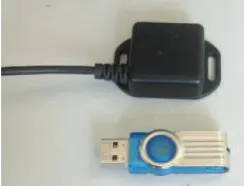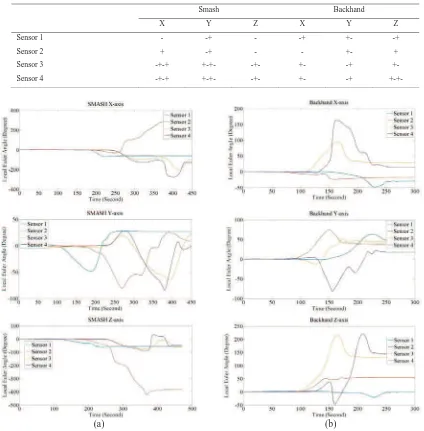2351-9789 © 2015 The Authors. Published by Elsevier B.V. This is an open access article under the CC BY-NC-ND license
6th International Conference on Applied Human Factors and Ergonomics (AHFE 2015) and the
Affiliated Conferences, AHFE 2015
Local Euler angle pattern recognition for smash and backhand in
badminton based on arm position
Muhammad Ilhamdi Rusydi
a,*, Minoru Sasaki
b,
Muhammad Hadi Sucipto
a
, Zaini
aNoverika Windasari
ca
Deparment of Electrical Engineering, Andalas University, Limau Manis, Padang City, 25163, Indonesia
b
Department of Mechanical Engineering, Gifu University, 1-1 Yanagido, Gifu City, 501-1193, Japan
c
Deparment of Medical, Andalas University, Limau Manis, Padang City, 25163, Indonesia
Abstract
Badminton is the most favourite sport in Indonesia. Since elementary school or earlier, children play badminton in a formal class or informal games. So, there are so many kind of styles in playing badminton. In this research, the pattern of arm kinesiology while playing badminton was studied, especially smash and backhand. The right arm of human was segmented into four parts: shoulder, elbow, wrist and back of hand. The 3-dimension local Euler angle of each parts was recorded by using gyro sensor made by Motion Node. The pattern of the segment position was investigated to distinguish smash and backhand. The result shows that there was a clear pattern caused by the movement of four parts of arm while performing smash and backhand. This pattern can be used to evaluate a process of arm moving while performing smash or backhand in badminton.
© 2015 The Authors. Published by Elsevier B.V. Peer-review under responsibility of AHFE Conference.
Keywords: Badminton; Smash; Euler angle; Backhand; Pattern
1.Introduction
The development of badminton in Indonesia was started in 1958 when they won Thomas Cup for the first time. Badminton was first held at the 1992 summer Olympics or twenty years after it is included as the demonstration sport at the 1972 summer Olympics. At the first even of badminton in summer Olympics, Indonesia successfully
* Corresponding author. Tel.: +6281261566525.
E-mail address: [email protected]
© 2015 The Authors. Published by Elsevier B.V. This is an open access article under the CC BY-NC-ND license (http://creativecommons.org/licenses/by-nc-nd/4.0/).
won two of four gold medals. After that, Indonesia always won gold medals in the next five summer Olympics. This condition give a big impact for Indonesian society. The government supports the facility to play badminton. It is easy to find people playing badminton in Indonesia. Badminton was taught since elementary school in Indonesia.
Even though badminton is one of the most widely sports in the world now, but the study on is still only a little. In medical, badminton is well known as a relatively low risk injury compared to other sports. Manir Arora et al., [1] were attracted by the fact that many badminton players suffer from shoulder pain despite relatively safe sport. The risk of suffering shoulder pain for both recreational and elite badminton players was over 50%. This condition happened to males and females. There is no difference for shoulder kinematics between man and female. Most of the shoulder pain in badminton was resulted by Subacromial Impingement, instability or Scapulothoracic Dyskinesia. Bob Chen et al., [2]
On other hand, the research about badminton technique is also very important. Study about badminton techniques also provides a wide and deep space for researchers since it still has many problems on it. C.-C. Chang, W.-C. Hsiung in [3] investigated about the effect of video instruction to study Fox Long Serve in badminton for students. They used two types of video feedback: Instant Video Feedback Group (IVFG) and Mass Video Feedback Group (MVFG) and analyzed with ANOVAs. They concluded that using IVFG students were able to perform the video instruction in long serve skill.
C-L Tsai et al., [4,5] studied the footwork in badminton using EMG signal. Rectus Femoris and Vastus Medialis had the most important role from a player touched the ground until the moment before contact with the shuttlecock. Jian Yu and Guojin Zhao [6] developed local sensory system for badminton racket. Two sensors, accelerometer and acoustic sensor, were attached on the badminton racket. Vibrating was read from the accelerometer and sound pressure was calculated from acoustic sensor. This research gave contribution to design badminton racket types.
Huajin et al., [7] studied about how a professional badminton player showed a great ability to predict the direction of the hit ball. This ability had significant difference compared with the non-player as the control. This research distinguished between professional badminton player and non-player ability to construct anticipation of the ball coming. David Alder et al., [8] distinguished some types of kinematics constructed by human arm, wrist and racket while performed badminton serves. Two groups of volunteers, expert and novice, were asked to anticipate the landing location of serves based on their visual search behavior.
Koon kiat Teu et al., [9] used electrogoniometer and dual Euler angles to study arm movement during the badminton smash. They provided a method to help players to effectively rotate the arm segment for producing racket head speed. Rui Jiang and Zhaonian Wang [10] using the infrared monitoring system investigated the biomechanics system of smashing motion. The standard of spiking was determined from the mechanic theory and the law of conservation energy.
Many research studied about how to get a strong power in smashing. This research focused on the basic technique in badminton using direction of local Euler angle gradient. Two types of hitting shuttlecock in badminton were investigated, smash and backhand, based on the 3-dimension arm position. Human arm was segmented into by four points: shoulder, elbow, wrist and back of hand. The segments position while performing smash and backhand was modelled.
2.Gyroscope
The sensor in this research was developed by motion node. This is a compact sensor designed for human motion tracking. The physical size is 35 mm x 35 mm x 15 mm. The weight is 10 grams. This motion node has three sensors inside, accelerometer, gyroscope and magnetometer. This study only used gyroscope sensor. It has range s
2000º/second. The sampling rate is 100 Hz. It can measure 360º range in all three axes. The error is about 0.5 to 2º RMS. This sensors was showed by Fig.1.
3.Methodology
Fig. 1. Motion Node Sensor.
Fig. 2. Four Sensor positions on right hand.
In this research the back of hand movement was considered to be affected by movement of shoulder, elbow, and wrist. In this case, the shoulder was the base and the back of hand was the end-effector. So, the configuration of sensor positions was design to cover the movements from base to the end-effector. Four sensor positions on the right hand were used in this research, as shown by Fig. 2. This sensor was connected to a computer for data acquisition. The data were saved in Microsoft excel format.
In order to get the pattern of smash and back hand, the position of shuttlecock relative to the human shoulder was set as fixed point. Fig. 3(a) shows the position of shuttlecock for smash. Fig 3(b) shows the position of shuttlecock for backhand. The left foot is in front of the right foot for smash. The right foot is in front of left foot for backhand. The shuttlecock was in front of the head. The normal line between the shuttlecock and the shoulder was orthogonal to the chest. The shuttlecock was hit in a straight line to the opponent field, as shown by Fig. 3(c).
Fig. 4. Representation of local Euler angle from motion node sensor.
Motion node sensor produces 3-axis local Euler angle for each segments. The pattern of arm movement was modelled by gradient of the local Euler angle. Two types of gradients were positive gradient and negative gradient. First, the algorithm created first reference point 1 (Ref_1), first positive threshold value (Th1_+) and first negative threshold value (Th1_-). If the local Euler angle bigger than Th1_+ than the signal was labelled as + (positive gradient). If the local Euler angle smaller than Th1_- than the signal was labelled as - (negative gradient). Then, the present value of Euler angle was compared to the previous value. For positive gradient, if the present value is smaller than the previous value, than ref_2, Th2_+, and Th2_- were created. The local Euler angle was labelled negative if it was smaller than Th2_-. For negative gradient, if the present value is bigger than the previous value, than ref_2, Th2_+, and Th2_- were created. The local Euler angle was labelled positive if it was bigger than Th2_+. Fig. 4 shows the illustration of the detection of arm movement pattern as the value of local Euler angle in second. Fig. 5 is the algorithm to detect the gradient pattern of the signal.
4. Result and analysis
Fig. 6. shows the representation graphic of local Euler angle for (a). smash and (b). backhand. From the graph, the pattern of local Euler angle gradient was recognized for both smash and backhand. In general, the data from five volunteers are shown by Table 1.
Table 1. The pattern of 3-axis local Euler angle gradient from 4 sensors.
Smash Backhand
X Y Z X Y Z
Sensor 1 - -+ - -+ +- -+
Sensor 2 + -+ - - +- +
Sensor 3 -+-+ +-+- -+- +- -+ +-
Sensor 4 -+-+ +-+- -+- +- -+ +-+-
(a) (b)
5.Conclusion
This research used four positions on arm attached by motion sensor. Smash and backhand pattern in badminton were modeled using direction of local Euler angle gradient. The result shows that smash and backhand had a different direction of local Euler angle gradient. For the next research, this study will record data from qualified coaches as the reference for the standard of smash and backhand. This method could be developed to distinguish all types of badminton hitting technique
Acknowledgements
This research was funded by Directorate General of Higher Education, Indonesian Ministry of Education and Culture, contract number: 030/SP2H/PL/DIT.LITABMAS/II/2015.
References
[1] Manit Arora, Sunil H. Shetty, Ravindra G. Khedekar, Sachin Kale. Over Hal of badminton players suffer from shoulder pain: Is impingement to blame?. Journal of Arthroscopy and Joint Surgery 2015; 2: 33-36.
[2] Bob Chen, Damon Mok, Winson C.C Lee, Wing Kai Lam. High-intensity stepwise conditioning programme for improved exercise response and agility performance of badminton knee pain. Physical Therapy in Sport 2015; 16:80-85.
[3] C.-C. Chang, W.-C. Hsiung. The impact of video instruction on the performance of male university students in beginning of badminton. Journal of Biomechanics 2006; 39: S560.
[4] C.-L. Tsai, C.-C. Yang, M.-S. Lin, K.-S. Huang, S.-S. Chang. The EMG activity of the lower extremities in badminton smash stroke 2006, 39, Supplement 1, S562. DOI: http://dx.doi.org/10.1016/S0021-9290(06)85321-2.
[5] C-L Tsai, K-M Pan, K-S Huang and S-S Chang. The surface EMG activity of the lower extremities in badminton footwork. Journal of Biomechanics 2007; 40: Supplement 2, S757. DOI: http://dx.doi.org/10.1016/S0021-9290(07)70745-5.
[6] Jian Yu, Guojin Zhao. Study on Badminton Smash for Training Based on Sensor. Proceedings of the 2nd International Conference on Green Communication and Networks 2012; Vol. 2. DOI: 10.1007/978-3-642-35567-7_46.
[7] Hua Jin, Guiping Xu, John X.Zhang, Hongwei Gao, Zuoer Ye, Pin Wang, Huiyan Lin, Lei Mo, Chong-De Lin. Event related potential effects of superior action anticipation in professional badminton players. Neuroscience Letters 2011; 402:130-144.
[8] David Alder, Paul R. Ford, Joe Causer, A. Mark Williams. The Coupling between gaze behavior and opponent kinematics during anticipation of badminton shots. Human Movement Science 2014, 37:167-179.
[9] Koon Kiat Teu, Wangdo Kim, John Tan, Franz Konstantin Fuss. Using dual Euler angles for the analysis of arm movement during the badminton smash. Sport Engineering 2005; 8:171-178.


